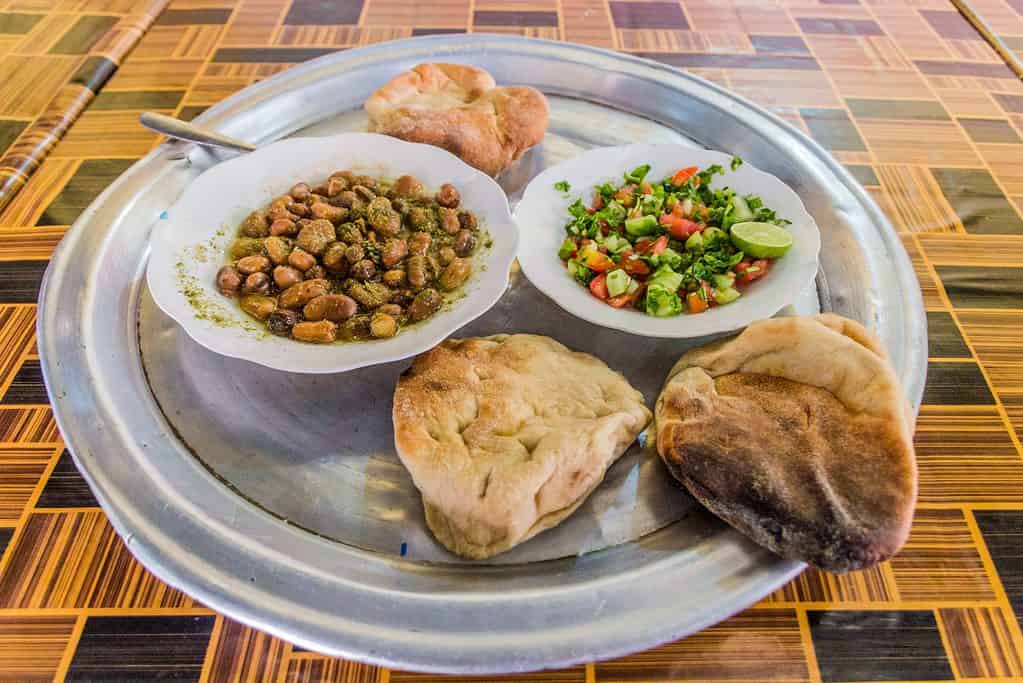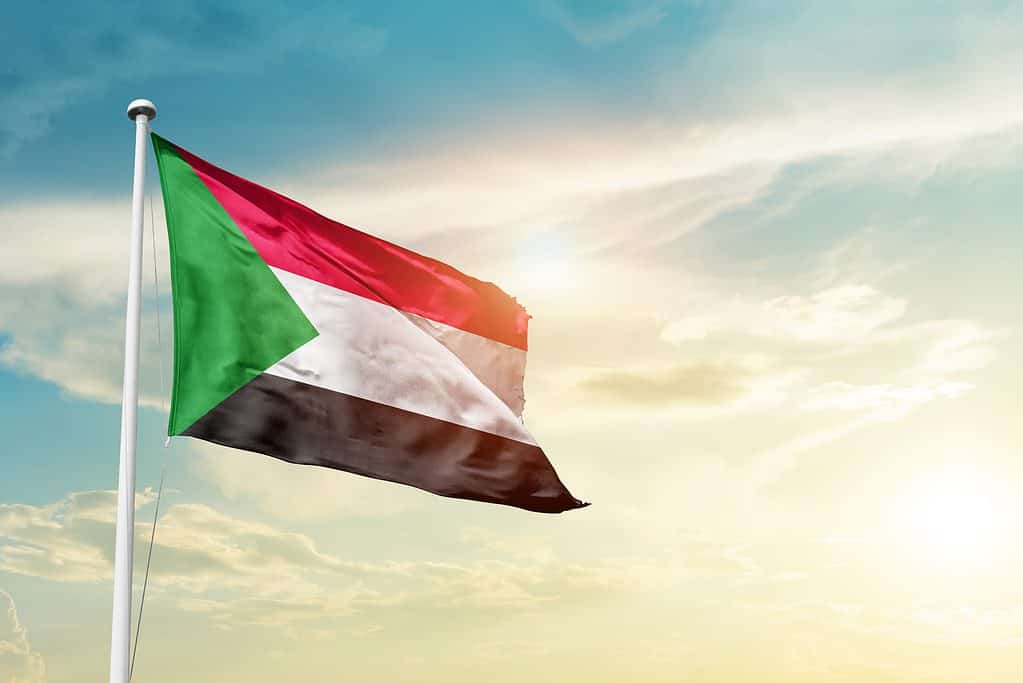The officially title of Sudan is the Republic of the Sudan. This country is located in Northeast Africa and shares a border with Egypt to the north. The population of Sudan is 45.7 million people, all living in an area of 728,215 square miles. The capital city of Sudan is Khartoum. The city with the highest population is Omdurman, with 2.3 million people living there.
Sudan: Geography and Climate
Sudan is in northern Africa and has 530 miles of coastline bordering the Red Sea. The terrain is mostly flat but contains a few mountain ranges. In the west, you can see the Marrah Mountains, a range of volcanic peaks 9,980 feet tall. In the east are the Red Sea Hills, a chain of mountains that run north-south parallel with the Red Sea.
The Blue Nile and White Nile rivers converge in Khartoum to form the Nile, which flows north toward Egypt and the Mediterranean Sea.
The southern part of Sudan gets more rain than the northern or central parts, which are arid deserts. You can also find grasslands, tropical savannas, and agricultural fields throughout the country. During the dry season, some sandstorms nearly block out the sun entirely.
Sudan: Politics and Economy
The government of Sudan has changed many times over the years, even as recently as 2019, when the country implemented a new constitutional charter. Officials signed a peace treaty in October 2020, but the violence, coup attempts, and uprisings have continued. The constitution of Sudan, which has an executive, parliament, and judiciary branch, created the government of Sudan, which is also a provisional federal government.
Sudan’s economy is rising, with oil its main export. For the citizens of Sudan, agriculture is a large source of income, with over 80 percent of Sudanese citizens working in the agriculture sector.
Sudan: Cuisine and Culture

Sudanese cooking includes a type of fava bean stew.
©Matyas Rehak/Shutterstock.com
There are 578 ethnic groups living in Sudan, and 145 dialects are spoken. This variety makes for a rich and unique region with a strong musical culture, a mixture of western and traditional attire, and a love for football.
The Nubian, Egyptian, Turkish, Arab, and Levantine cuisines influence Sudanese cooking. Some of the most common foods include lamb, a bread called aisha, savory stews, fava beans, and falafel.
Flag of Sudan: Description

The white stripe on Sudan’s flag represents the people’s optimism, light, and hope.
©em_concepts/Shutterstock.com
The current flag of Sudan was adopted in 1970. It shows three horizontal stripes of equal size. The top stripe is red, the middle is white, and the bottom stripe is black. At the left is a green triangle pointing toward the middle.
Flag of Sudan: Symbolism
Red, white, and green are pan-Arab colors and have represented Islamic religions and Arab people for many centuries. The colors stand for the unity and independence of the Arab people. The red stripe represents Sudan’s struggle for freedom and the many sacrifices of the people. The white stripe represents the people’s optimism, light, and hope. White also stands for the White Flag League, which rose against colonial rule in 1924. The black stripe represents Sudan, as the word Sudan means “land of the black people.” The black flag also symbolizes the nationalists who fought against colonial rule in the late 19th century. Green stands for Islam and is also the color of a prosperous land with thriving agriculture.
Flag of Sudan: History and Variations
There have been many flags in Sudan over the years. Here are a few of them.
1899-1956 During this time period, Egypt and the United Kingdom shared the rule of Sudan. The two countries could not agree on one flag. Instead, they flew the flag of Egypt and the flag of the United Kingdom simultaneously.
1956-1969 Flag of the Republic of Sudan. After gaining independence from Egypt and the United Kingdom in 1956, Sudan created a new flag. This flag showed three horizontal stripes of equal size. The colors were blue, yellow, and green from top to bottom. These colors symbolized the River Nile in blue, the Sahara Desert in yellow, and the abundant farmlands of Sudan in green. It was purposely designed to be neutral to all ethnic groups and political parties.
1969-1985 Flag of the Democratic Republic of the Sudan. In 1969 a major coup changed the political structure of Sudan. As a result, the country was renamed the Democratic Republic of the Sudan, and a contest was held to design the new flag. The winning flag was adopted in May 1970 and consisted of three horizontal stripes in the pan-Arab colors of red, white, and black. Additionally, a green triangle took up one-third of the flag to the left and pointed toward the center.
1989-2019. In June of 1989, a military coup was led by Colonel Omar al-Bashir. This coup was successful. It suspended the other political parties and introduced an Islamic legal code to the nation. Al-Bashir appointed himself President. During this time, the government flew the previous red, white and black flag.
2019-Current. At the very end of 2018, large protests began, resulting in the government’s overthrow in the spring of 2019. Omar al-Bashir was arrested, and a Transitional Military Council became the ruling government. As of 2021, the country is jointly led by the Chairman of the Transitional Sovereign Council and the Prime Minister. The flag enacted in 1970 (red, white, and black stripes, with a green triangle to the left) is still in place.
NEXT UP…
- The Flag of Cuba: History, Meaning, and Symbolism
- The Flag of Mexico: History, Meaning, and Symbolism
- The Flag of Uzbekistan: History, Meaning, and Symbolism
The photo featured at the top of this post is © Anastasilia Guseva/Shutterstock.com
Sources
- TandF online, Available here: https://www.tandfonline.com/doi/pdf/10.1080/13530199208705560
- Web Archive, Available here: https://web.archive.org/web/20160402220838/http://www.ucdp.uu.se/gpdatabase/gpcountry.php?id=145®ionSelect=1-Northern_Africa
- Web Archive, Available here: https://web.archive.org/web/20090825232557/http://www.icc-cpi.int/menus/icc/press%20and%20media/press%20releases/press%20releases%20%282008%29/a
- FOTW, Available here: https://www.fotw.info/flags/sd-hist.html#cond
- FOTW, Available here: https://www.fotw.info/flags/sd-hist.html#cond"
- Pro Thomalo, Available here: https://en.prothomalo.com/international/Breakthrough-agreement-between-Sudan-protest
Thank you for reading! Have some feedback for us? Contact the AZ Animals editorial team.






